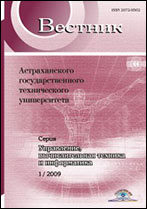|
This article is cited in 2 scientific papers (total in 2 papers)
INFORMATION TECHNOLOGIES IN EDUCATIONAL ACTIVITY
Hybrid model for constructing individual educational trajectory based on digital twins
N. V. Kaznacheevaa, A. N. Poletaikinb, L. F. Danilovaa, S. G. Sinitsab
a Siberian State University of Telecommunications and Information Science,
Novosibirsk, Russian Federation
b Kuban State University,
Krasnodar, Russian Federation
Abstract:
The article focuses on building an individual educational trajectory of a university
student. This concept is formalized in the form of a hybrid mathematical model. This model is
based on a structural model of educational competence. In this case, the competence is a basic construct of the educational program, it acts as a prototype of the structural model of individualized
educational content. The main source of semantic and control information is the digital twin system. The digital double of the educational program formalizes its structure and content in strict accordance with the regulatory requirements of federal state educational standards. The digital twin
of a student fixes and processes his digital tracks throughout his life. The digital twin of the labor
market formalizes the structure of a certain segment of the labor market in the context of the requirements for professional and personal qualities of specialists. There has been substantiated the
need for proactive management of restructuring and rebranding the professional educational programs in accordance with the changes at the labor market. A significant contribution to the management of these evolutionary processes is made by the dynamics of a student’s activity, which is
reflected in his digital traces. Hybridization of these digital twins into the system of constructing
individual educational trajectory allows the semantic marking and weighing of the educational situation and projected content. Based on a suspended educational content and taking into account the
regulatory requirements of educational standards and additional requirements of the educational organization, optimization modeling of an individual educational trajectory in its structural and meaningful context is carried out. The study of the structural features of the constructed hybrid mathematical model made it possible to determine and substantiate its rational structure.
Keywords:
labor market requirements, student's needs, individual educational trajectory, educational content, semantic proximity, hybrid model.
Received: 26.06.2021
Citation:
N. V. Kaznacheeva, A. N. Poletaikin, L. F. Danilova, S. G. Sinitsa, “Hybrid model for constructing individual educational trajectory based on digital twins”, Vestn. Astrakhan State Technical Univ. Ser. Management, Computer Sciences and Informatics, 2021, no. 4, 126–136
Linking options:
https://www.mathnet.ru/eng/vagtu700 https://www.mathnet.ru/eng/vagtu/y2021/i4/p126
|

| Statistics & downloads: |
| Abstract page: | 70 | | Full-text PDF : | 65 | | References: | 15 |
|




 Contact us:
Contact us: Terms of Use
Terms of Use
 Registration to the website
Registration to the website Logotypes
Logotypes







 Citation in format
Citation in format 
